Rare Geological Find is now at Heritage Center
Thanks to an unexpected discovery at a Lake Oswego construction site, a new historical artifact is now display outside the Tualatin Heritage Center.
This article is largely based on Josh Kulla’s reporting in Tualatin Life.
A two-ton chunk of rhyolite, a type of igneous rock that is not normally found in our area, is believed to have been deposited in the Willamette Valley by the Missoula Floods around 15,000 years ago. It was found during excavation of the new Lakeridge Junior High School site in Lake Oswego. Scott Burns, a Professor Geology at Portland State University and the President of the Tualatin Ice Age Foundation Board, said the find is unique in his many years of research experience and will be a key display piece for the future visitor center the Foundation hopes to one day open in Tualatin.
This huge chunk of rhyolite was found during excavation work at the new Lakeridge Junior High School project in Lake Oswego. The boulder is believed to have come from Montana or further north in Canada and floated to Oregon a chunk of glacier during the massive Missoula Flood some 15,000 years ago. (Courtesy/Scott Burns)
“We believe it’s an ice-rafted glacial erratic,” Burns said. “That is, it fell onto the glaciers up in British Columbia, Alberta, Canada or Montana and then was part of the dam that blew apart in the Missoula Floods and it floated down here and was then dropped.
“I’ve never seen an ice-rafted erratic like this, not at all.”
The rhyolite is a mottled yellow, green and brown boulder roughly three feet by three feet by four feet in size. It was found by a Jacob Parker, keen-eyed construction superintendent with Skanska USA Building, the general contractor for the Lakeridge Junior High School project, following the excavation of the site. Parker called Rick and Sylvia Thompson, the president and secretary of the Lower Columbia chapter of the Ice Age Flood Institute, to notify them of the discovery. The Thompsons, in turn, notified Burns, who immediately made his way to Lake Oswego to check it out for himself.
“I went over and took a look at it and I was very excited,” Burns said. “I said we need to have this because it’s so different and we’ve never seen an erratic like this one.”
Because there are hundreds of excavated boulders that still need to be removed from the building site, talks between the Foundation and the Lake Oswego School District quickly produced an agreement that would allow the Foundation to take possession of the boulder.


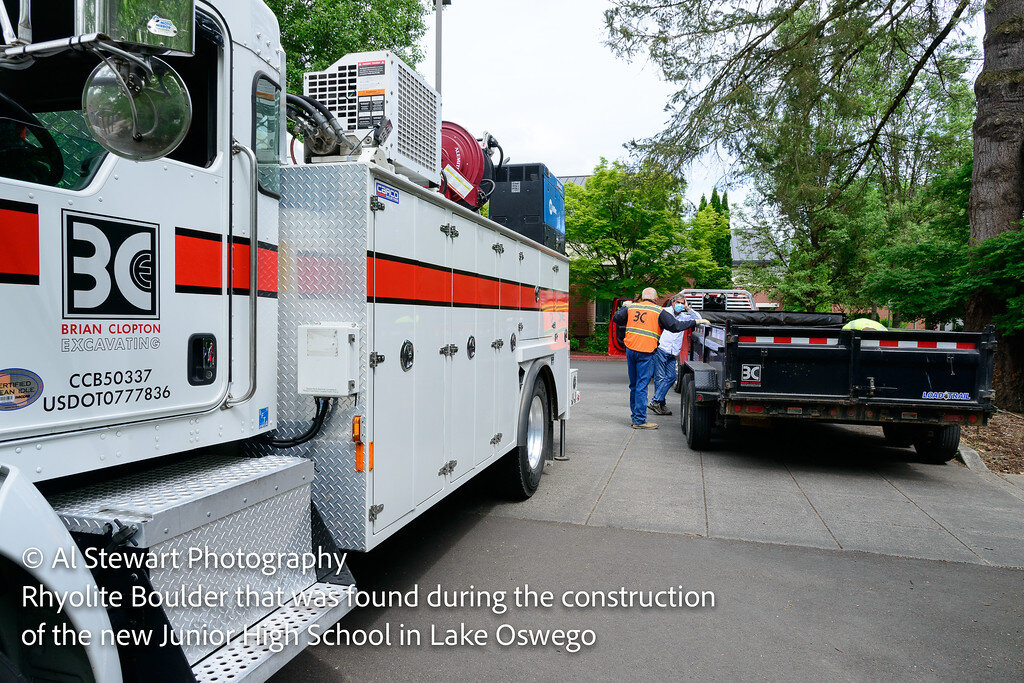

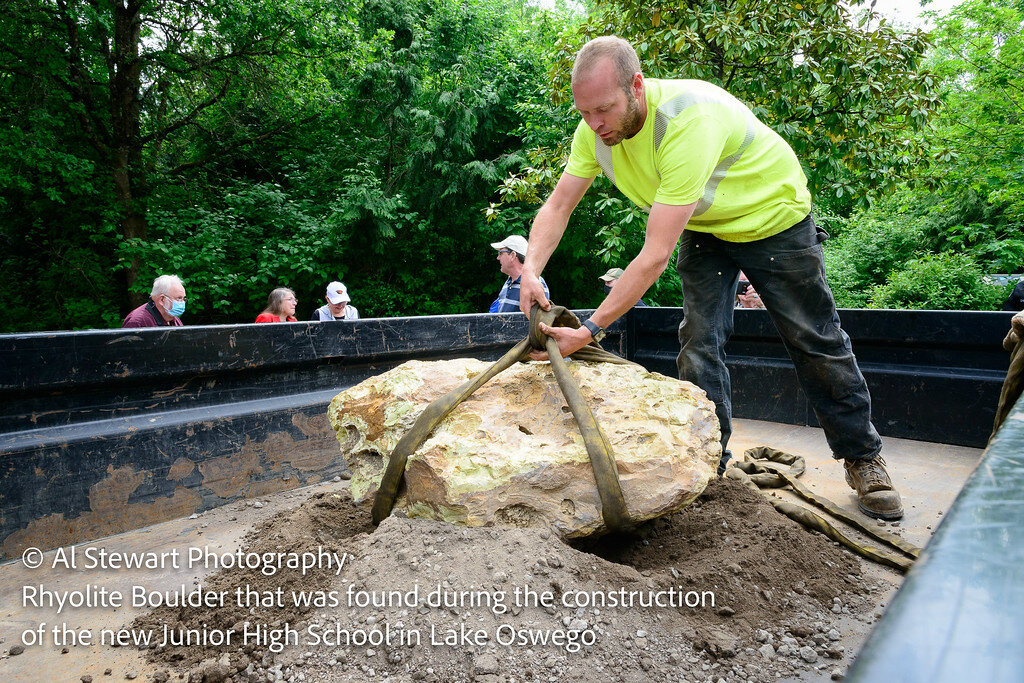
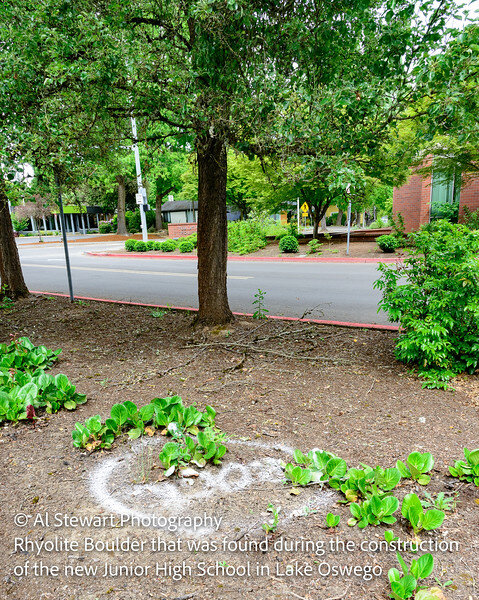


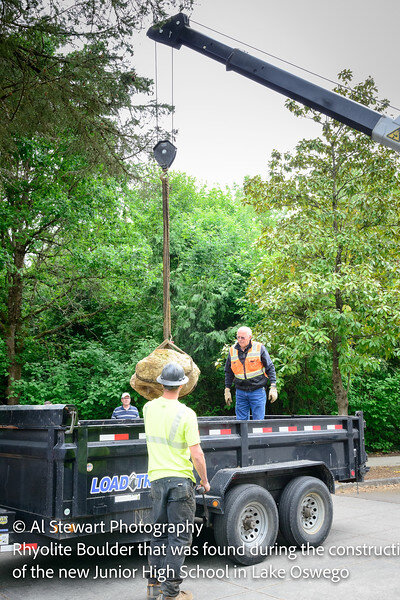
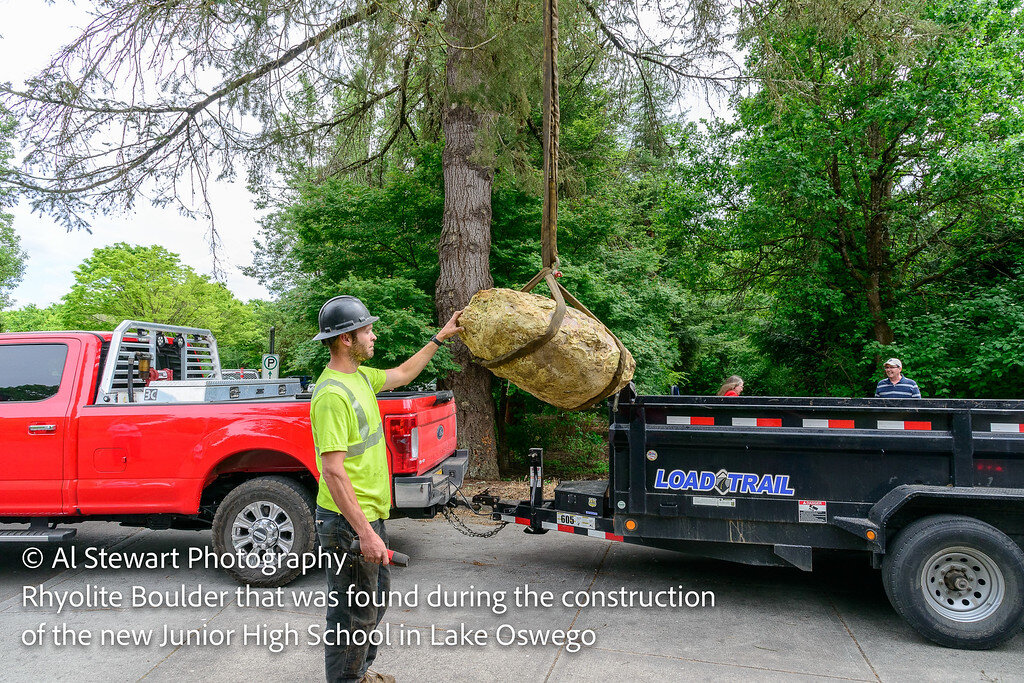
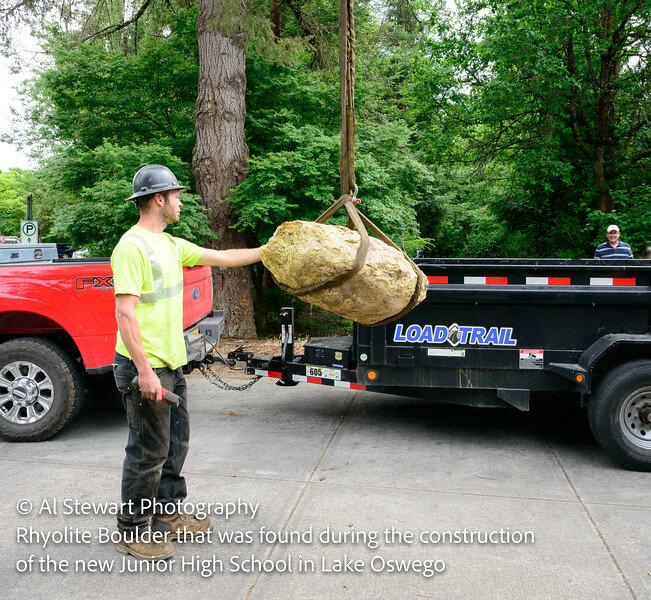
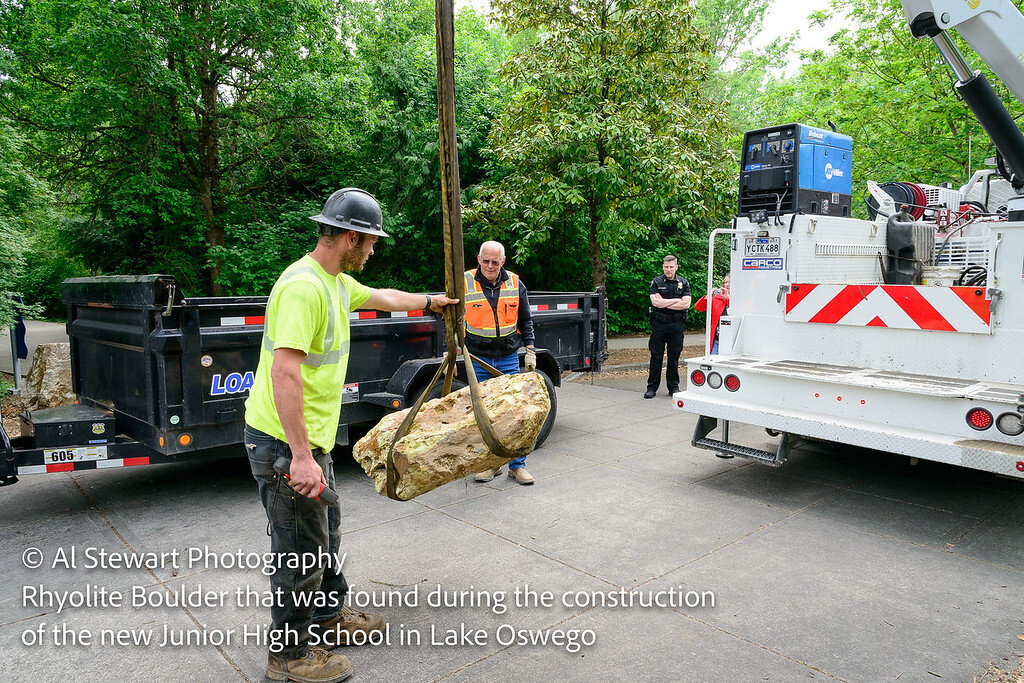
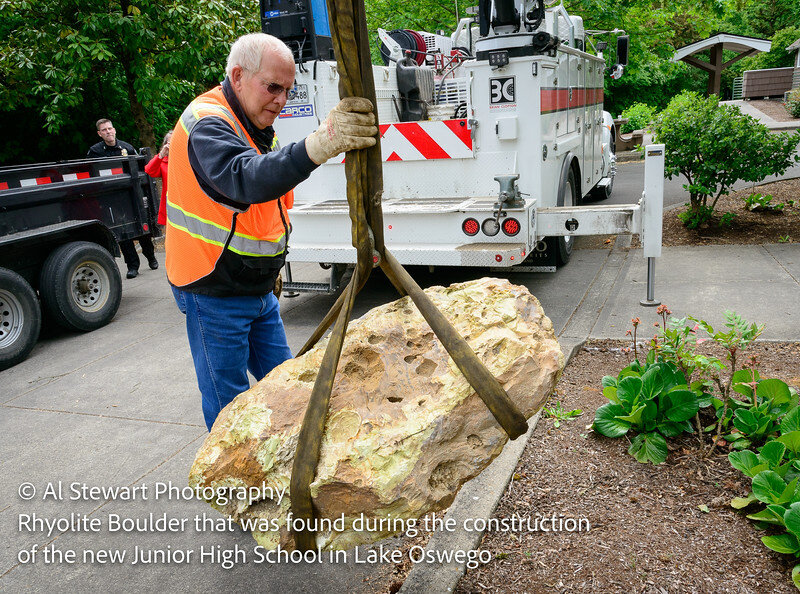
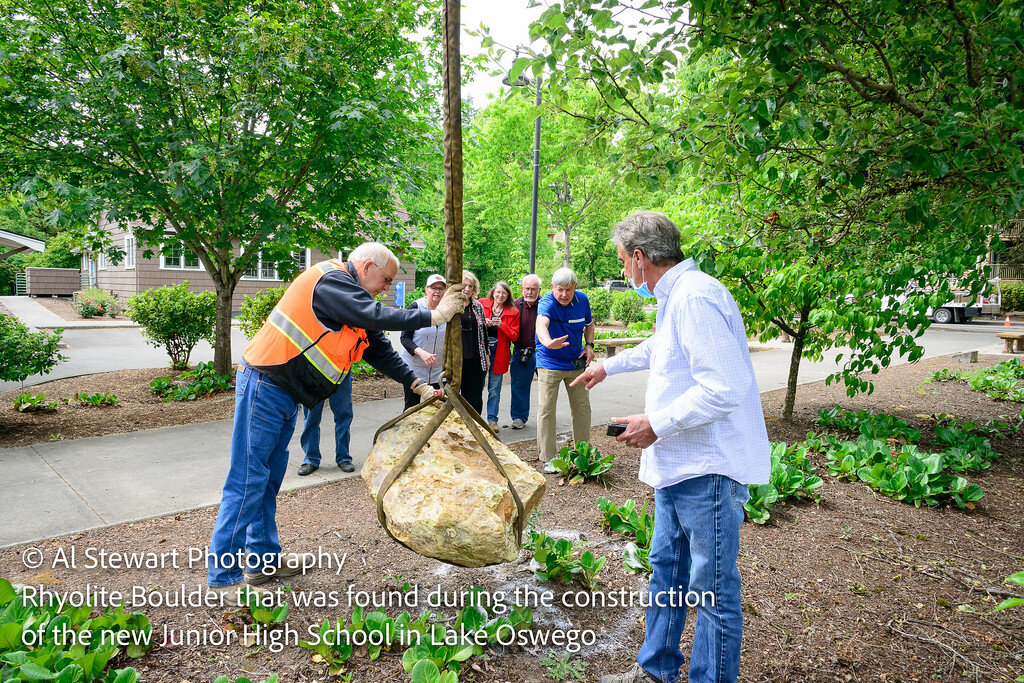
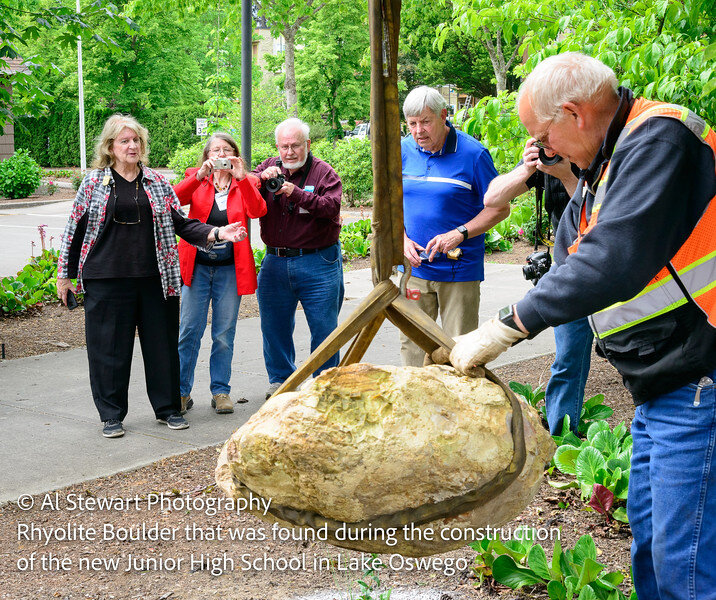


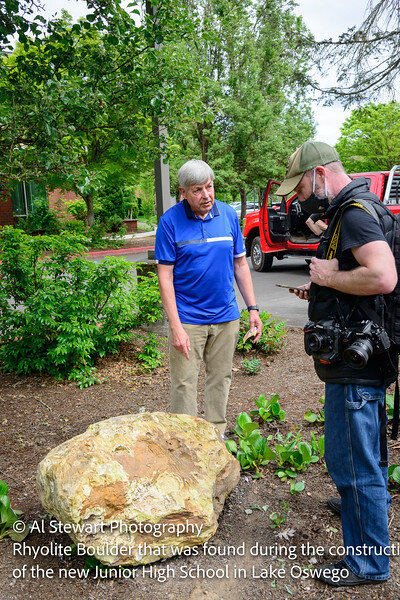
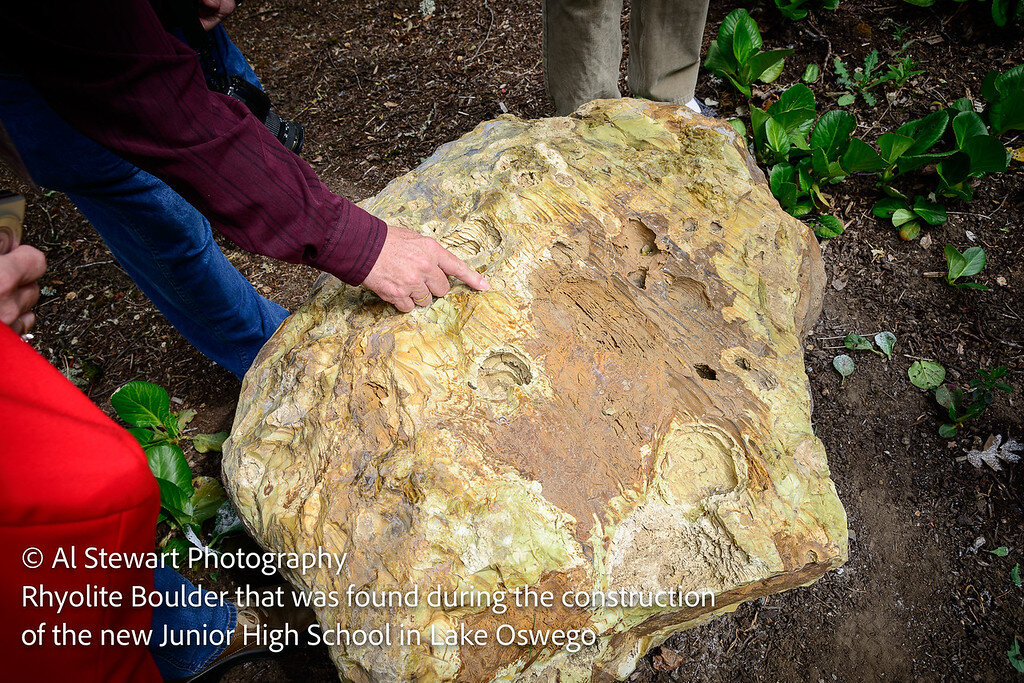
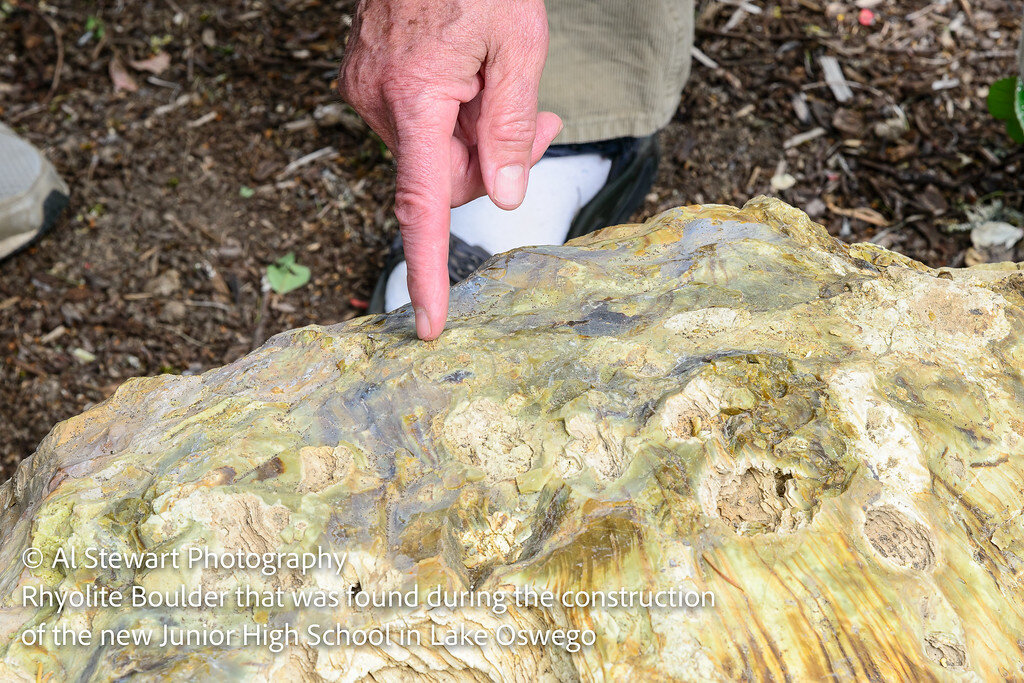
SLIDE SHOW OF THE DELIVERY TO THE TUALATIN HERITAGE CENTER.
Photos provided by Al Stewart Photography - order prints here
Skanska Construction Press Release
Construction crews find and preserve 15,000-year-old boulder unearthed at site of new Lakeridge Middle School
(Lake Oswego, Ore.) – Skanska, the construction contractor building the new Lakeridge Middle School at 4700 Jean Road in Lake Oswego, recently discovered during excavation a 15,000-year-old boulder with a distinct look and texture that seemed vastly different from other rocks and debris in the surrounding area.
“I walked through and examined all of the rocks we unearthed and this boulder stood out as very unique in color and texture,” said Skanska Senior Site Superintendent Jacob Parker. “I quickly realized it may have some historical or geological significance.” Once brought to light, the boulder measured three feet long, three feet wide and two feet high, weighing in at approximately 2,000 pounds.
The boulder Parker uncovered is rhyolite, a volcanic rock not known this side of the Cascade Mountains. It was moved to the area by one of the great Missoula Floods from either eastern Oregon or as far away as Canada on an iceberg, according to local geology professor and president of the Tualatin Ice Age Tourism Foundation, Scott Burns, Ph.D. The school district and Skanska immediately contacted Dr. Burns at Portland State University when the boulder was first discovered.
“This is a major geological find,” said Dr. Burns. “Of all of the hundreds of boulders moved to the Willamette Valley by the Missoula Floods, this is only the second rhyolite boulder recorded here.” According to Dr. Burns, “Excavation of the boulders at the site shows that they were deposited here sometime between 15,000 to 18,000 years ago. Most of the unearthed boulders are composed of basalt, but this large formation of rhyolite likely arrived here thousands of years ago.”
“We have a significant real-life learning opportunity for the students here at Lakeridge with this
amazing history right under our feet,” said Kurt Schultz, Ed.D., principal for the Lake Oswego School District. “Once students graduate from Lakeridge Middle School they are freshman and will study geoscience–so they’ll have first-hand experience with a piece of historical earth science found right at their school,” added Principal Schultz.
“This is a very special and unique find,” adds Anthony Vandenberg, executive director of project management for the school district. He noted the district will move and donate the geological relic to the Tualatin Ice Age Tourism Foundation at the Tualatin Heritage Center on May 17, 2021, where it will be available for public viewing.
Rhyolite boulder now in front of the Heritage Center
The boulder is believed to have come from Montana or further north in Canada and floated to Oregon a chunk of glacier during the massive Missoula Flood some 15,000 years ago.
Fellow Foundation board member Yvonne Addington arranged for Wilsonville firm Brian Clopton Excavating to transport the specimen from Lake Oswego to the Heritage Center. Rick Thompson of the Ice Age Floods Institute and his wife Sylvia joined Police Chief Bill Steele, Dr Burns, Yvonne Addington, Ice Age Treasurer Linda Moholt, Park Maintenance Manager Tom Steiger, the Clopton Excavating crew, Ross Baker from the Historical Society, photographer Al Stewart and photojournalist Josh Kulla at the Heritage Center. In the next months interpretive information will be placed next to the stone.
Portland State University, the University of Oregon and the Ice Age Floods Institute, Lower Columbia chapter have, for years, been researching the prehistory of Tualatin. The National Park Service long ago identified Tualatin as a key Ice Age Floods National Geologic Trail hub. To date, the City has made efforts to display the area’s ice age prehistory by the development of the Tualatin River Greenway Trail.
“We’re a small facility and we pride ourselves on the exhibits we have both inside and out,” said Ross Baker, President of the Tualatin Historical Society, which operates the Heritage Center. “The ice age items allow us to do both, because inside we have the mastodon tusk and other information, but outside is cool because the erratic rocks are there along with the heritage garden, and the overall blend is always improving. Every time the Ice Age fans get excited it’s always good for us.”
Read the full original article: Rare Geological Find is Headed to Tualatin - Tualatin Life
Rock the News!
Rhyolite boulder at Lakeridge MS
KATU-TV Ch 2 (ABC)
Rare rock discovered at Lake Oswego construction site
Rhyolite boulder at Lakeridge MS
PSU Website
Portland State professor identifies 15,000 year old boulder at site of new Lake Oswego middle school
Rhyolite boulder at Lakeridge MS
KGW-TV (NBC)
Construction crews find ancient boulder
Rhyolite boulder at Lakeridge MS
ABC30 St. Louis
Rare rock discovered at Lake Oswego construction site
Rhyolite boulder at Lakeridge MS
UPI
2,000-pound rare rock unearthed at Oregon construction site
Rhyolite boulder at Lakeridge MS
Newsweek
Extremely rare rock dating back to ice age discovered in Oregon


